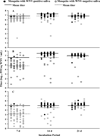Relationships between infection, dissemination, and transmission of West Nile virus RNA in Culex pipiens quinquefasciatus (Diptera: Culicidae)
- PMID: 22308781
- PMCID: PMC3320798
- DOI: 10.1603/me10280
Relationships between infection, dissemination, and transmission of West Nile virus RNA in Culex pipiens quinquefasciatus (Diptera: Culicidae)
Abstract
Culex pipiens quinquefasciatus Say fed blood containing 6.8 +/- 0.3 logs (mean +/- SE) plaque-forming units of West Nile virus (WNV)/ml were maintained at 28 degrees C for incubation periods (IP) of 7, 14, or 21 d. Several attributes of vector competence were determined at each IP using quantitative real-time reverse transcriptase polymerase chain reaction to estimate plaque forming unit equivalents including: infection rate (WNV-positive abdomens), dissemination rate (WNV-positive legs or thoraces), combined dissemination rate (WNV-positive legs and thoraces), transmission rate (WNV-positive saliva), and WNV titers in abdomens, legs, thoraces, and saliva. Each rate increased or was equivalent with increasing IP. Mosquitoes transmitting WNV in saliva also had significantly higher IP-dependent WNV titers in abdomens, legs, and thoraces. Titers of WNV in abdomens were significantly correlated with titers in legs and thoraces, but the degree of association changed with IP. However, titers of abdomens, legs, and thoraces were not correlated with WNV presence or titer in the saliva. The results show that WNV presence or titer in the saliva of infected Cx. p. quinquefasciatus was not directly influenced by processes involved in WNV replication in other tissues. The processes controlling midgut infection and escape are, in part, independent from the infection processes in other tissues. The relationship between infection, dissemination, and transmission varied over time. The infection and replication of WNV in different tissues is likely influenced by different barriers encountered during the extrinsic incubation period. The significance of these observations for understanding vector competence is discussed.
Figures


Similar articles
-
Vector competence of Culex pipiens quinquefasciatus (Diptera: Culicidae) for West Nile virus isolates from Florida.Trop Med Int Health. 2014 May;19(5):610-7. doi: 10.1111/tmi.12277. Epub 2014 Feb 12. Trop Med Int Health. 2014. PMID: 24898274 Free PMC article.
-
Impact of extrinsic incubation temperature and virus exposure on vector competence of Culex pipiens quinquefasciatus Say (Diptera: Culicidae) for West Nile virus.Vector Borne Zoonotic Dis. 2007 Winter;7(4):629-36. doi: 10.1089/vbz.2007.0101. Vector Borne Zoonotic Dis. 2007. PMID: 18021028 Free PMC article.
-
Impact of West Nile virus dose and incubation period on vector competence of Culex nigripalpus (Diptera: Culicidae).Vector Borne Zoonotic Dis. 2011 Nov;11(11):1487-91. doi: 10.1089/vbz.2010.0229. Epub 2011 Jul 14. Vector Borne Zoonotic Dis. 2011. PMID: 21756030 Free PMC article.
-
The contribution of Culex pipiens complex mosquitoes to transmission and persistence of West Nile virus in North America.J Am Mosq Control Assoc. 2012 Dec;28(4 Suppl):137-51. doi: 10.2987/8756-971X-28.4s.137. J Am Mosq Control Assoc. 2012. PMID: 23401954 Review.
-
West Nile virus: the Indian scenario.Indian J Med Res. 2003 Sep;118:101-8. Indian J Med Res. 2003. PMID: 14700342 Review.
Cited by
-
Temperature and dengue virus infection in mosquitoes: independent effects on the immature and adult stages.Am J Trop Med Hyg. 2013 Mar;88(3):497-505. doi: 10.4269/ajtmh.12-0421. Epub 2013 Feb 4. Am J Trop Med Hyg. 2013. PMID: 23382163 Free PMC article.
-
Experimental Infection of Newly Hatched Domestic Ducklings via Japanese Encephalitis Virus-Infected Mosquitoes.Pathogens. 2020 May 12;9(5):371. doi: 10.3390/pathogens9050371. Pathogens. 2020. PMID: 32408553 Free PMC article.
-
Reproductive biology and susceptibility of Florida Culex coronator to infection with West Nile virus.Vector Borne Zoonotic Dis. 2014 Aug;14(8):606-14. doi: 10.1089/vbz.2013.1501. Vector Borne Zoonotic Dis. 2014. PMID: 25072992 Free PMC article.
-
Effects of virus dose and extrinsic incubation temperature on vector competence of Culex nigripalpus (Diptera: Culicidae) for St. Louis encephalitis virus.J Med Entomol. 2012 Nov;49(6):1502-6. doi: 10.1603/me12054. J Med Entomol. 2012. PMID: 23270182 Free PMC article.
-
The role of innate immunity in conditioning mosquito susceptibility to West Nile virus.Viruses. 2013 Dec 13;5(12):3142-70. doi: 10.3390/v5123142. Viruses. 2013. PMID: 24351797 Free PMC article. Review.
References
-
- Anderson JF, Main AJ, Delroux K, Fikrig E. Extrinsic incubation periods for horizontal and vertical transmission of West Nile virus by Culex pipiens pipiens (Diptera: Culicidae) J. Med. Entomol. 2008;45:445–451. - PubMed
-
- Blitvitch BJ. Transmission dynamics and changing epidemiology of West Nile virus. Anim. Health Res. Rev. 2008;9:71–86. - PubMed
Publication types
MeSH terms
Substances
Grants and funding
LinkOut - more resources
Full Text Sources

